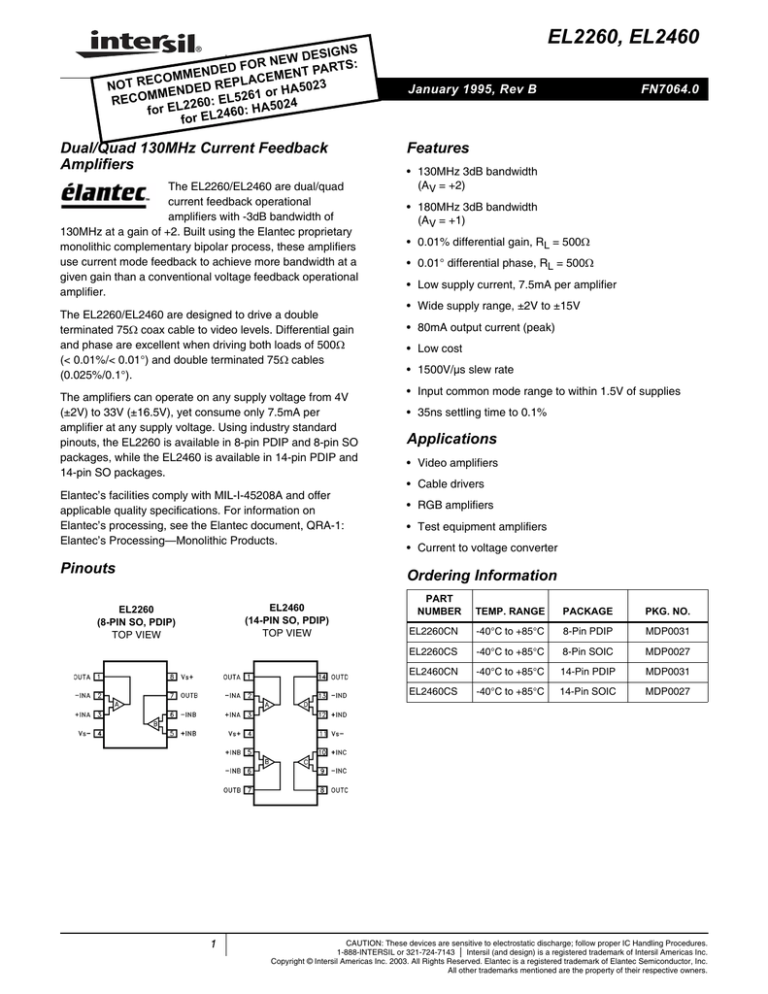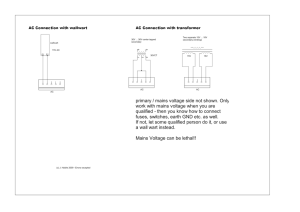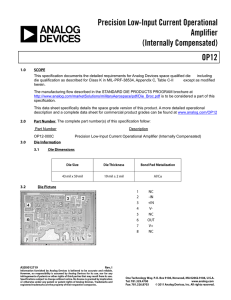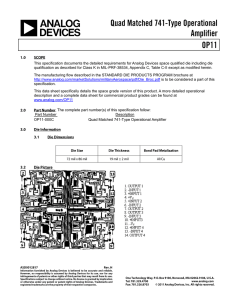
IGNS
W DES S:
E
N
R
O
T PART
NDED F
COMME REPLACEMEN 23
E
R
T
O
N
D
Data
HA5 0
MENDE
1 orSheet
RECOM L2260: EL526 5024
fo r E
460: HA
for EL2
EL2260, EL2460
®
Dual/Quad 130MHz Current Feedback
Amplifiers
The EL2260/EL2460 are dual/quad
current feedback operational
amplifiers with -3dB bandwidth of
130MHz at a gain of +2. Built using the Elantec proprietary
monolithic complementary bipolar process, these amplifiers
use current mode feedback to achieve more bandwidth at a
given gain than a conventional voltage feedback operational
amplifier.
The EL2260/EL2460 are designed to drive a double
terminated 75Ω coax cable to video levels. Differential gain
and phase are excellent when driving both loads of 500Ω
(< 0.01%/< 0.01°) and double terminated 75Ω cables
(0.025%/0.1°).
The amplifiers can operate on any supply voltage from 4V
(±2V) to 33V (±16.5V), yet consume only 7.5mA per
amplifier at any supply voltage. Using industry standard
pinouts, the EL2260 is available in 8-pin PDIP and 8-pin SO
packages, while the EL2460 is available in 14-pin PDIP and
14-pin SO packages.
Elantec’s facilities comply with MIL-I-45208A and offer
applicable quality specifications. For information on
Elantec’s processing, see the Elantec document, QRA-1:
Elantec’s Processing—Monolithic Products.
Pinouts
January 1995, Rev B
FN7064.0
Features
• 130MHz 3dB bandwidth
(AV = +2)
• 180MHz 3dB bandwidth
(AV = +1)
• 0.01% differential gain, RL = 500Ω
• 0.01° differential phase, RL = 500Ω
• Low supply current, 7.5mA per amplifier
• Wide supply range, ±2V to ±15V
• 80mA output current (peak)
• Low cost
• 1500V/µs slew rate
• Input common mode range to within 1.5V of supplies
• 35ns settling time to 0.1%
Applications
• Video amplifiers
• Cable drivers
• RGB amplifiers
• Test equipment amplifiers
• Current to voltage converter
Ordering Information
EL2460
(14-PIN SO, PDIP)
TOP VIEW
EL2260
(8-PIN SO, PDIP)
TOP VIEW
1
PART
NUMBER
TEMP. RANGE
PACKAGE
PKG. NO.
EL2260CN
-40°C to +85°C
8-Pin PDIP
MDP0031
EL2260CS
-40°C to +85°C
8-Pin SOIC
MDP0027
EL2460CN
-40°C to +85°C
14-Pin PDIP
MDP0031
EL2460CS
-40°C to +85°C
14-Pin SOIC
MDP0027
CAUTION: These devices are sensitive to electrostatic discharge; follow proper IC Handling Procedures.
1-888-INTERSIL or 321-724-7143 | Intersil (and design) is a registered trademark of Intersil Americas Inc.
Copyright © Intersil Americas Inc. 2003. All Rights Reserved. Elantec is a registered trademark of Elantec Semiconductor, Inc.
All other trademarks mentioned are the property of their respective owners.
EL2260, EL2460
Absolute Maximum Ratings (TA = 25°C)
Voltage between VS+ and VS-. . . . . . . . . . . . . . . . . . . . . . . . . .+33V
Voltage between +IN and -IN. . . . . . . . . . . . . . . . . . . . . . . . . . . .±6V
Current into +IN or -IN . . . . . . . . . . . . . . . . . . . . . . . . . . . . . . . 10mA
Internal Power Dissipation . . . . . . . . . . . . . . . . . . . . . . . See Curves
Operating Ambient Temperature Range . . . . . . . . . .-40°C to +85°C
Operating Junction Temperature
Plastic Packages . . . . . . . . . . . . . . . . . . . . . . . . . . . . . . . . . . . 150°C
Storage Temperature Range . . . . . . . . . . . . . . . . . .-65°C to +150°C
Output Current . . . . . . . . . . . . . . . . . . . . . . . . . . . . . . . . . . . . ±50mA
CAUTION: Stresses above those listed in “Absolute Maximum Ratings” may cause permanent damage to the device. This is a stress only rating and operation of the
device at these or any other conditions above those indicated in the operational sections of this specification is not implied.
IMPORTANT NOTE: All parameters having Min/Max specifications are guaranteed. Typical values are for information purposes only. Unless otherwise noted, all tests
are at the specified temperature and are pulsed tests, therefore: TJ = TC = TA
Open-Loop DC Electrical Specifications
VS = ±15V, RL = 150Ω, TA = 25°C unless otherwise specified.
LIMITS
PARAMETER
VOS
DESCRIPTION
Input Offset Voltage
CONDITIONS
VS = ±5V, ±15V
TEMP
MIN
25°C
TYP
MAX
2
10
mV
15
mV
TMIN, TMAX
TC VOS
Average Offset Voltage Drift (Note 1)
+IIN
+Input Current
VS = ±5V, ±15V
Full
10
25°C
0.5
TMIN, TMAX
-IIN
-Input Current
VS = ±5V, ±15V
25°C
5
TMIN, TMAX
CMRR
Common Mode Rejection Ratio
(Note 2)
VS = ±5V, ±15V
Full
-ICMR
-Input Current Common
Mode Rejection (Note 2)
VS = ±5V, ±15V
25°C
Power Supply Rejection Ratio (Note 3)
Full
-IPSR
-Input Current Power Supply Rejection
(Note 3)
25°C
Transimpedance (Note 4)
VS = ±15V
RL = 400Ω
+Input Resistance
+CIN
+Input Capacitance
CMIR
Common Mode Input Range
VO
ISC
Output Voltage Swing
Output Short Circuit Current (Note 5)
2
0.2
25°C
500
TMIN, TMAX
250
25°C
500
TMIN, TMAX
250
Full
1.5
5
µA
10
µA
25
µA
35
µA
dB
5
µA/V
5
µA/V
95
TMIN, TMAX
VS = ±5V
RL = 150Ω
+RIN
0.2
75
µV/°C
55
TMIN, TMAX
PSRR
ROL
50
UNITS
dB
5
µA/V
5
µA/V
2000
kΩ
kΩ
1800
kΩ
kΩ
3.0
MΩ
25°C
2.5
pF
VS = ±15V
25°C
±13.5
V
VS = ±5V
25°C
±3.5
V
RL = 400Ω,
VS =±15V
25°C
±12
±13.5
V
TMIN, TMAX
±11
RL = 150Ω,
VS =±15V
25°C
RL = 150Ω,
VS =±5V
25°C
±3.0
TMIN, TMAX
±2.5
25°C
60
VS = ±5V, VS = ±15V
V
±12
V
±3.7
V
V
100
150
mA
EL2260, EL2460
Open-Loop DC Electrical Specifications
VS = ±15V, RL = 150Ω, TA = 25°C unless otherwise specified. (Continued)
LIMITS
PARAMETER
IS
DESCRIPTION
Supply Current (Per Amplifier)
CONDITIONS
TEMP
VS = ±15V
MIN
25°C
TYP
MAX
7.5
11.0
mA
11.0
mA
8.5
mA
8.5
mA
TMIN, TMAX
VS = ±5V
25°C
5.4
TMIN, TMAX
ROL
Transimpedance (Note 6)
VS = ±15V
RL = 400Ω
25°C
500
UNITS
2000
kΩ
NOTES:
1. Measured from TMIN to TMAX.
2. VCM = ±10V for VS = ±15V and TA= Full
VCM = ±3V for VS = ±5V and TA = 25°C
VCM = ±2V for VS = ±5V and TA = TMIN, TMAX
3. The supplies are moved from ±2.5V to ±15V.
4. The supplies are moved from ±2.5V to ±15V.
5. A heat sink is required to keep junction temperature below absolute maximum when an output is shorted.
6. The supplies are moved from ±2.5V to ±15V.
Closed-Loop AC Electrical Specifications
VS = ±15V, AV = +2, RF = 560Ω, RL = 150Ω, TA = 25°C unless otherwise noted
LIMITS
PARAMETER
BW
SR
DESCRIPTION
-3dB Bandwidth (Note 1)
Slew Rate (Note 1) (Note 2)
TEST CONDITIONS
MIN
TYP
UNITS
MAX
VS = ±15V, AV = +2
130
MHz
VS = ±15V, AV = +1
180
MHz
VS = ±5V, AV = +2
100
MHz
VS = ±5V, AV = +1
110
MHz
1500
V/µs
1500
V/µs
2.7
ns
3.2
ns
RL = 400Ω
1000
RF = 1kΩ, RG = 110Ω
RL = 400Ω
tR, tF
Rise Time, Fall Time (Note 1)
tPD
Propagation Delay (Note 1)
OS
Overshoot (Note 1)
VOUT = ±500mV
0
%
tS
0.1% Settling Time (Note 1)
VOUT = ±10V
35
ns
RL = 150Ω
0.025
%
RL = 500Ω
0.006
%
RL = 150Ω
0.1
deg (°)
RL = 500Ω
0.005
deg (°)
VOUT = ±500mV
AV = -1, RL = 1k
dG
dP
Differential Gain (Note 1)(Note 3)
Differential Phase (Note 1)(Note 3)
NOTES:
1. All AC tests are performed on a “warmed up” part, except for Slew Rate, which is pulse tested.
2. Slew Rate is with VOUT from +10V to -10V and measured at the 25% and 75% points.
3. DC offset from -0.714V through +0.714V, AC amplitude 286mVP-P, f = 3.58MHz.
3
EL2260, EL2460
Typical Performance Curves
Non-Inverting Frequency
Response (Gain)
Inverting Frequency
Response (Gain)
3dB Bandwidth vs Supply Voltage
for AV = -1
4
Non-Inverting Frequency
Response (Phase)
Inverting Frequency
Response (Phase)
Peaking vs Supply Voltage
for AV = -1
Frequency Response
for Various RL
Frequency Response for
Various RF and RG
3dB Bandwidth vs
Temperature for AV = - 1
EL2260, EL2460
Typical Performance Curves
(Continued)
3dB Bandwidth vs Supply
Voltage for AV = +1
Peaking vs Supply Voltage
for AV = +1
3dB Bandwidth vs Supply
Voltage for AV = +2
Peaking vs Supply Voltage
for AV = +2
3dB Bandwidth vs Supply
Voltage for AV = +10
Peaking vs Supply Voltage
for AV = +10
5
3dB Bandwidth vs Temperature
for AV = +1
3dB Bandwidth vs Temperature
for AV = +2
3dB Bandwidth vs Temperature
for AV = +10
EL2260, EL2460
Typical Performance Curves
Frequency Response
for Various CL
PSRR and CMRR
vs Frequency
Voltage and Current Noise
vs Frequency
6
(Continued)
Frequency Response
for Various CIN-
2nd and 3rd Harmonic
Distortion vs Frequency
Closed-Loop Output
Impedance vs Frequency
Channel to Channel
Isolation vs Frequency
Transimpedance (ROL)
vs Frequency
Transimpedance (ROL)
vs Die Temperature
EL2260, EL2460
Typical Performance Curves
Offset Voltage
vs Die Temperature
(4 Samples)
+Input Resistance
vs Die Temperature
Output Voltage Swing
vs Die Temperature
7
(Continued)
Supply Current
vs Die Temperature
(Per Amplifier)
Supply Current
vs Supply Voltage
(Per Amplifier)
Input Current
vs Die Temperature
+Input Bias Current
vs Input Voltage
Short Circuit Current
vs Die Temperature
PSRR & CMRR
vs Die Temperature
EL2260, EL2460
Typical Performance Curves
(Continued)
Differential Gain
vs DC Input Voltage,
RL = 150
Differential Phase
vs DC Input Voltage,
RL = 150
Differential Gain
vs DC Input Voltage,
RL = 500
Differential Phase
vs DC Input Voltage,
RL = 500
Slew Rate
vs Supply Voltage
8
Small Signal
Pulse Response
Large Signal
Pulse Response
Slew Rate
vs Temperature
EL2260, EL2460
Typical Performance Curves
(Continued)
Settling Time
vs Settling Accuracy
14-Pin Plastic DIP
Maximum Power Dissipation
vs Ambient Temperature
14-Pin Plastic SO
Maximum Power Dissipation
vs Ambient Temperature
Long Term Settling Error
8-Pin Plastic DIP
Maximum Power Dissipation
vs Ambient Temperature
8-Pin Plastic SO
Maximum Power Dissipation
vs Ambient Temperature
Burn-In Circuits
EL2460
EL2260
9
EL2260, EL2460
Differential Gain and Phase Test Circuit
Simplified Schematic (One Amplifier)
10
EL2260, EL2460
Applications Information
Product Description
The EL2260/EL2460 are dual and quad current mode
feedback amplifiers that offer wide bandwidths and good
video specifications at moderately low supply currents. They
are built using Elantec’s proprietary complimentary bipolar
process and are offered in industry standard pinouts. Due to
the current feedback architecture, the EL2260/EL2460
closed-loop 3dB bandwidth is dependent on the value of the
feedback resistor. First the desired bandwidth is selected by
choosing the feedback resistor, RF, and then the gain is set
by picking the gain resistor, RG. The curves at the beginning
of the Typical Performance Curves section show the effect
of varying both RF and RG. The 3dB bandwidth is somewhat
dependent on the power supply voltage. As the supply
voltage is decreased, internal junction capacitances
increase, causing a reduction in closed loop bandwidth. To
compensate for this, smaller values of feedback resistor can
be used at lower supply voltages.
Power Supply Bypassing and Printed Circuit
Board Layout
As with any high frequency device, good printed circuit
board layout is necessary for optimum performance. Ground
plane construction is highly recommended. Lead lengths
should be as short as possible, below 1/4”. The power
supply pins must be well bypassed to reduce the risk of
oscillation. A 1.0µF tantalum capacitor in parallel with a
0.01µF ceramic capacitor is adequate for each supply pin.
For good AC performance, parasitic capacitances should be
kept to a minimum, especially at the inverting input (see
Capacitance at the Inverting Input section). This implies
keeping the ground plane away from this pin. Carbon
resistors are acceptable, while use of wire-wound resistors
should not be used because of their parasitic inductance.
Similarly, capacitors should be low inductance for best
performance. Use of sockets, particularly for the SO
packages, should be avoided. Sockets add parasitic
inductance and capacitance which will result in peaking and
overshoot.
In the inverting gain mode, added capacitance at the
inverting input has little effect since this point is at a virtual
ground and stray capacitance is therefore not “seen” by the
amplifier.
Feedback Resistor Values
The EL2260 and EL2460 have been designed and specified
with RF = 560Ω for AV = +2. This value of feedback resistor
yields extremely flat frequency response with little to no
peaking out to 130MHz. As is the case with all current
feedback amplifiers, wider bandwidth, at the expense of
slight peaking, can be obtained by reducing the value of the
feedback resistor. Inversely, larger values of feedback
resistor will cause rolloff to occur at a lower frequency. By
reducing RF to 430Ω, bandwidth can be extended to
170MHz with under 1dB of peaking. Further reduction of RF
to 360Ω increases the bandwidth to 195MHz with about
2.5dB of peaking. See the curves in the Typical Performance
Curves section which show 3dB bandwidth and peaking vs.
frequency for various feedback resistors and various supply
voltages.
Bandwidth vs Temperature
Whereas many amplifier’s supply current and consequently
3dB bandwidth drop off at high temperature, the
EL2260/EL2460 were designed to have little supply current
variations with temperature. An immediate benefit from this
is that the 3dB bandwidth does not drop off drastically with
temperature. With VS = ±15V and AV = +2, the bandwidth
only varies from 150MHz to 110MHz over the entire die
junction temperature range of 0°C < T < 150°C.
Supply Voltage Range
The EL2260/EL2460 has been designed to operate with
supply voltages from ±2V to ±15V. Optimum bandwidth,
slew rate, and video characteristics are obtained at higher
supply voltages. However, at ±2V supplies, the 3dB
bandwidth at AV = +2 is a respectable 70MHz. The following
figure is an oscilloscope plot of the EL2260 at ±2V supplies,
AV = +2, RF = RG = 560Ω, driving a load of 150Ω, showing a
clean ±600mV signal at the output.
Capacitance at the Inverting Input
Due to the topology of the current feedback amplifier, stray
capacitance at the inverting input will affect the AC and
transient performance of the EL2260/EL2460 when
operating in the non-inverting configuration. The
characteristic curve of gain vs. frequency with variations of
CIN- emphasizes this effect. The curve illustrates how the
bandwidth can be extended to beyond 200MHz with some
additional peaking with an additional 2pF of capacitance at
the VIN- pin for the case of AV = +2. Higher values of
capacitance will be required to obtain similar effects at
higher gains.
11
If a single supply is desired, values from +4V to +30V can be
used as long as the input common mode range is not
exceeded. When using a single supply, be sure to either 1)
EL2260, EL2460
DC bias the inputs at an appropriate common mode voltage
and AC couple the signal, or 2) ensure the driving signal is
within the common mode range of the EL2260/EL2460.
Settling Characteristics
The EL2260/EL2460 offer superb settling characteristics to
0.1%, typically in the 35ns to 40ns range. There are no
aberrations created from the input stage which often cause
longer settling times in other current feedback amplifiers.
The EL2260/EL2460 are not slew rate limited, therefore any
size step up to ±10V gives approximately the same settling
time.
As can be seen from the Long Term Settling Error curve, for
AV = +1, there is approximately a 0.035% residual which
tails away to 0.01% in about 40µs. This is a thermal settling
error caused by a power dissipation differential (before and
after the voltage step). For AV = -1, due to the inverting
mode configuration, this tail does not appear since the input
stage does not experience the large voltage change as in
the non-inverting mode. With AV = -1, 0.01% settling time is
slightly greater than 100ns.
Power Dissipation
The EL2260/EL2460 amplifiers combine both high speed
and large output current drive capability at a moderate
supply current in very small packages. It is possible to
exceed the maximum junction temperature allowed under
certain supply voltage, temperature, and loading conditions.
To ensure that the EL2260/EL2460 remain within their
absolute maximum ratings, the following discussion will help
to avoid exceeding the maximum junction temperature.
Unlike some amplifiers, such as the LT1229 and LT1230,
the EL2260/EL2460 maintain almost constant supply current
over temperature so that AC performance is not degraded
as much over the entire operating temperature range. Of
course, this increase in performance doesn’t come for free.
Since the current has increased, supply voltages must be
limited so that maximum power ratings are not exceeded.
Each amplifier in the EL2260/EL2460 consume typically
7.5mA and maximum 10.0mA. The worst case power in an
IC occurs when the output voltage is at half supply, if it can
go that far, or its maximum value if it cannot reach
half supply. If we assume that the EL2260/EL2460 is used
for double terminated video cable driving applications
(RL = 150Ω), and the gain = +2, then the maximum output
voltage is 2V, and the average output voltage is 1.4V. If we
set the two PDmax equations equal to each other, and solve
for VS, we can get a family of curves for various packages
and conditions according to:
R L × ( T JMAX – T AMAX )
--------------------------------------------------------------- + ( V OUT )
N × θ JA
V S = ------------------------------------------------------------------------------------------( 2 × I S × R L ) + V OUT
The following curve shows supply voltage (±VS) vs.
temperature for the various packages assuming AV = + 2,
RL = 150, and VOUT peak = 2V. The curves include worst
case conditions (IS = 10mA and all amplifiers operating at
VOUT peak = 2V).
Supply Voltage vs Ambient Temperature
for All Packages of EL2260/EL2460
The maximum power dissipation allowed in a package is
determined by its thermal resistance and the amount of
temperature rise according to:
T JMAX – T AMAX
P DMAX = --------------------------------------------θ JA
The maximum power dissipation actually produced by an IC
is the total quiescent supply current times the total power
supply voltage plus the power in the IC due to the load, or
V OUT⎞
⎛
P DMAX = N × ⎜ 2 × V S × I S + ( V S – V OUT ) × ----------------⎟
RL ⎠
⎝
where N is the number of amplifiers per package, and IS is
the current per amplifier. (To be more accurate, the
quiescent supply current flowing in the output driver
transistor should be subtracted from the first term because,
under loading and due to the class AB nature of the output
stage, the output driver current is now included in the second
term.)
In general, an amplifier’s AC performance degrades at
higher operating temperature and lower supply current.
12
The curves do not include heat removal or forcing air, or the
simple fact that the package will probably be attached to a
circuit board, which can also provide some form of heat
removal. Larger temperature and voltage ranges are
possible with heat removal and forcing air past the part.
Current Limit
The EL2260/EL2460 have internal current limits that protect
the circuit in the event of the output being shorted to ground.
This limit is set at 100mA nominally and reduces with
junction temperature. At a junction temperature of 150°C,
the current limits at about 65mA. If any one output is shorted
to ground, the power dissipation could be well over 1W, and
much greater if all outputs are shorted. Heat removal is
EL2260, EL2460
required in order for the EL2260/EL2460 to survive an
indefinite short.
Channel to Channel Isolation
Due to careful biasing connections within the internal
circuitry of the EL2260/EL2460, exceptionally good channel
to channel isolation is obtained. Isolation is over 70dB at
video frequencies of 4MHz, and over 65dB up to 10MHz.
The EL2460 isolation is improved an additional 10dB, up to
about 5MHz, for amplifiers A to B and amplifiers C to D.
Isolation is improved another 8dB for amplifiers A to C and
amplifiers B to D. See the curve in the Typical Performance
Curves section for more detail.
Driving Cables and Capacitive Loads
When used as a cable driver, double termination is always
recommended for reflection-free performance. For those
applications, the back termination series resistor will
decouple the EL2260 and EL2460 from the capacitive cable
and allow extensive capacitive drive. However, other
applications may have high capacitive loads without
termination resistors. In these applications, an additional
small value (5Ω–50Ω) resistor in series with the output will
eliminate most peaking. The gain resistor, RG, can be
chosen to make up for the gain loss created by this
additional series resistor at the output.
13
EL2260, EL2460
EL2260/EL2460 Macromodel
* Revision A, March 1993
* AC Characteristics used CIN- (pin 2) = 1pF; RF = 560Ω
* Connections:
+input
*
| -input
*
| |
+Vsupply
*
| |
|
-Vsupply
*
| |
|
|
output
*
| |
|
|
|
.subckt EL2260/EL 3 2 7 4 6
*
* Input Stage
*
e1 10 0 3 0 1.0
vis 10 9 0V
h2 9 12 vxx 1.0
r1 2 11 130
l1 11 12 25nH
iinp 3 0 0.5µA
iinm 2 0 5µA
r12 3 0 2Meg
*
* Slew Rate Limiting
*
h1 13 0 vis 600
r2 13 14 1K
d1 14 0 dclamp
d2 0 14 dclamp
*
* High Frequency Pole
*
*e2 30 0 14 0 0.00166666666
l3 30 17 0.43µH
c5 17 0 0.27pF
r5 17 0 500
*
* Transimpedance Stage
*
g1 0 18 17 0 1.0
ro1 18 0 2Meg
cdp 18 0 2.285pF
*
* Output Stage
*
q1 4 18 19 qp
q2 7 18 20 qn
q3 7 19 21 qn
q4 4 20 22 qp
r7 21 6 4
r8 22 6 4
ios1 7 19 2mA
ios2 20 4 2mA
*
* Supply Current
*
ips 7 4 2mA
*
* Error Terms
*
ivos 0 23 2mA
14
EL2260, EL2460
vxx 23 0 0V
e4 24 0 3 0 1.0
e5 25 0 7 0 1.0
e6 26 0 4 0 1.0
r9 24 23 562
r10 25 23 1K
r11 26 23 1K
*
* Models
*
.model qn npn (is=5e-15 bf=100 tf=0.1ns)
.model qp pnp (is=5e-15 bf=100 tf=0.1ns)
.model dclamp d (is=1e-30 ibv=0.266 bv=2.24 n=4)
.ends
All Intersil U.S. products are manufactured, assembled and tested utilizing ISO9000 quality systems.
Intersil Corporation’s quality certifications can be viewed at www.intersil.com/design/quality
Intersil products are sold by description only. Intersil Corporation reserves the right to make changes in circuit design, software and/or specifications at any time without
notice. Accordingly, the reader is cautioned to verify that data sheets are current before placing orders. Information furnished by Intersil is believed to be accurate and
reliable. However, no responsibility is assumed by Intersil or its subsidiaries for its use; nor for any infringements of patents or other rights of third parties which may result
from its use. No license is granted by implication or otherwise under any patent or patent rights of Intersil or its subsidiaries.
For information regarding Intersil Corporation and its products, see www.intersil.com
15






